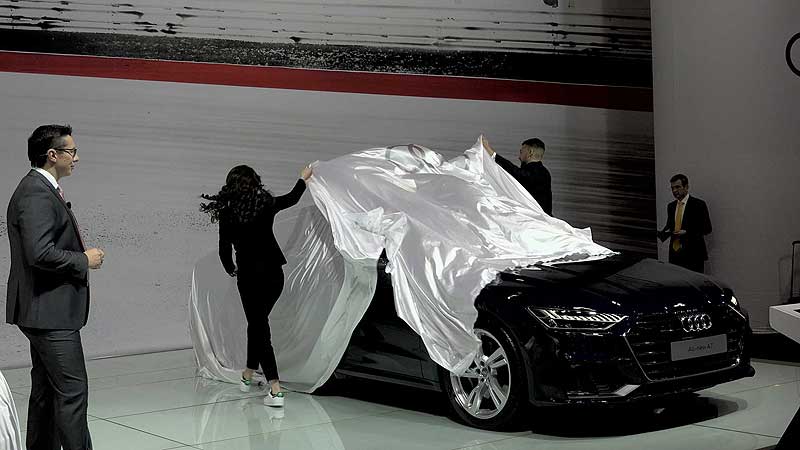🚗 2018 Canadian International AutoShow. The New Audi A7 Sportback Debut
Wednesday, 21 February 2018 07:01.PM
- The new Audi A7 Sportback: Sportiness in its most beautiful form
The new Audi A7 Sportback is a new style of Gran Turismo, offering systematic digitalization, a dynamic driving experience and a space concept that combines a wide range of customer requirements. The large four-door coupé is the essence of Audi’s new design language.
The second-generation A7 Sportback is the essence of Audi’s new design language and brings the show car design of the prologue studies to production. The four-door coupé is full of innovations – in terms of networking and digitalization, the sporty-confident driving experience, as well as its versatile space concept.
Combined fuel consumption in l/100 km: 7.2 – 5.5* (32.7 – 42.8 US mpg); Combined CO2 emissions in g/km: 163 – 142* (262.3 – 228.5 g/mi) * Fuel consumption and CO2 emission figures given in ranges depend on the tires/wheels used.
Progressive sportiness: the exterior design
The exterior design of the new A7 Sportback emphatically embodies Audi’s new, progressive design language focused on large surfaces, sharp edges and alternating light and shadows.
The wide, low Singleframe grille and prominent air inlets express the dynamic character of the Gran Turismo at first glance. With the two optional headlight variants, twelve separate horizontal lighting strips create the lighting signature. Topping the line are the HD Matrix LED headlights with Audi laser light, which can be recognized by the blue marker in the reflector.
Viewed from the side, pronounced contours emphasize the large wheels –a reference to Audi’s quattro genes. The sharply dropping roof line dominates the silhouette. The large coupé is 4.97 meters (16.3 ft) long and 1.91 meters (6.3 ft) wide, but just 1.42 meters (4.7 ft) high. Its rear is tapered like a yacht. A spoiler integrated into the long luggage
compartment lid extends electrically at 120 km/h (74.6 mph). A light strip connects the rear lights, whose outer rear lights comprise 13 segments each. When the doors are unlocked or closed, dynamic lighting animations in the rear lights and headlights showcase the Audi A7.
Broad-based electrification: Mild hybrid system for all engines
The new Audi A7 Sportback’s drive system is now even more efficient thanks to a new mildhybrid system (MHEV). At market introduction the coupé will be available with either a 3.0 TFSI or a 3.0 TDI engine. With either engine, the MHEV system is based on a 48-volt primary electrical system and a belt alternator starter (BAS) generating up to 12 kilowatts of recuperation power. The A7 Sportback can coast with the engine off over a wide speed range and then restart smoothly via the BAS. The start-stop function now activates at 22 km/h (13.7 mph). The 3.0 TFSI is mated to a seven-speed S tronic; the 3.0 TDI to an eight-speed tiptronic. In combination with the S tronic, the quattro drivetrain uses the efficient ultra technology that activates rear-wheel drive as needed.
The 3.0 TFSI, a turbocharged V6, has an output of 250 kW (340 hp) and 500 Nm (368.8 lb-ft) of torque. It accelerates the four-door coupé from 0 to 100 km/h (62.1 mph) in 5.3 seconds on its way to a top speed of 250 km/h (155.3 mph). In the NEDC, the base version of the Audi A7 Sportback 55 TFSI consumes 6.8 liters of fuel per 100 kilometers (34.6 US mpg), corresponding to 154 grams CO2 per kilometer (247.8 g/mi)*. The 3.0 TDI produces 210 (286 hp) and 620 Nm (457.3 lb-ft) of torque, and accelerates from 0 to 100 km (62.1 mph) in 5.7 seconds. It consumes in the base version just 5.5 liters of fuel per 100 kilometers (42.8 US mpg) in the NEDC, corresponding to 142 grams CO2 per kilometer (228.5 g/mi). Additional four and six-cylinder engines will follow after the market introduction in early March 2018.
The body concept: Coupe, Sedan and Avant in one
The design of a coupe, the space of a sedan and the variability of an Avant – the new Audi A7 Sportback combines the best of three worlds. Compared to the predecessor model, its interior has grown in length by 21 millimeters (0.8 in). The luggage compartment has a base size of 535 liters (18.9 cu ft) and can be expanded up to 1,390 liters (49.1 cu ft) with the backrests folded down. Body attachments are made of lightweight aluminum. The Gran Turismo gets top marks for stiffness, crash safety, aerodynamics and aeroacoustics.
-
Related materials:
- 05-Apr-2024 05:21 PM 🚗 2024 Canadian International AutoShow - Explore KIA🏎️🚘🚙 (4K, images)
- 05-Apr-2024 04:23 PM 🚗 2024 Canadian International AutoShow. Explore Kia 🏎️🚘🚙
- 04-Apr-2024 06:03 AM 🚗 2024 Canadian International AutoShow. Explore NISSAN 🏎️🚘🚙 (4K HDR, images)
- 04-Apr-2024 05:07 AM 🚗 Explore NISSAN/INFINITY at the Canadian International AutoShow 2024. Global Autoshow Debut 🏎️🚘🚙
- 31-Mar-2024 10:34 PM 🚗 2024 Canadian International AutoShow. Explore the Fisker Ocean One 🏎️🚘🚙 (4K HDR, images)
- 31-Mar-2024 09:36 PM 🚗 2024 Canadian International AutoShow. Explore the Fisker Ocean One 🏎️🚘🚙
- 29-Mar-2024 02:21 PM 🚗 Porsche Presenting Five Premieres at the 2024 Canadian International AutoShow 🏎️🚘🚙 (4K HDR, images)
- 29-Mar-2024 01:25 PM 🚗 2024 Canadian International AutoShow. Porsche Presenting Five Premieres 🏎️🚘🚙
- 25-Mar-2024 12:46 AM 🚗 2024 Canadian International AutoShow. 50 Years of Grand Touring Automobiles 🏎️🚘🚙 (4K HDR, images)
- 24-Mar-2024 11:50 PM 🚗 2024 Canadian International AutoShow. 50 Years of Grand Touring Automobiles 🏎️🚘🚙
